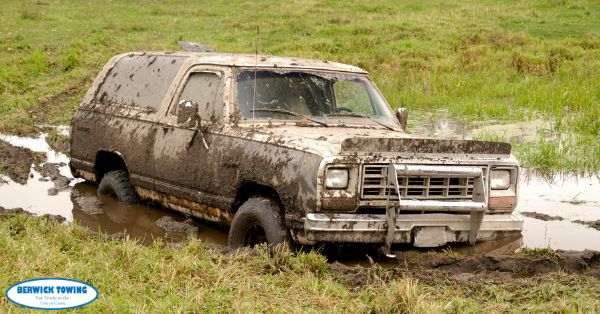is guide will walk you through the best things to do (and not to do) as well as who to call when you’re stuck.
1. Expect to Get Stuck in the Mud
Motorists fall into one of two camps – they either consider getting stuck in the mud an unpredictable or unpreventable inconvenience, or they go looking for it. The latter is a fun and exciting challenge if you’re a mudding enthusiast, though it can be quite stressful for everyone else!
It’s always best to prepare your vehicle as if running into mud is inevitable, no matter with camp you belong to. Avid mudders should be sure they have the right truck for the job, and they should regularly maintain their vehicle to reduce the odds of getting stuck.
The maintenance rule applies to all drivers, as does fitting the vehicle with features like mud flaps, which prevent road debris from packing into tire treads, reducing traction. Mud tires or all-terrain tires can provide a better grip on slick terrain, making it important to know the difference between those tires as well as which type fits your vehicle best.
2. Rock Out of the Mud
Try switching into 4-wheel drive and locking your differential, if your vehicle has these features, then quickly downshift into low gear. Move your gear shift swiftly between drive and reverse as you begin to roll forward, starting a rocking motion. This movement helps level the surface of the mud, providing better traction for your tires. Gradually increase the acceleration to help you roll out. This will at the very least create a better surface for a tow truck to be able to pull you out.
3. Turn Your Wheels to the Side
Turning your wheels to the side is more effective when your treads are in good condition, as it can help a car that is stuck in mud get a grip on the road. You will know it’s working when you begin emerging from the rut, so when you do you should keep moving forward by applying steady pressure to the gas pedal.
4. Increase Traction
There are other ways to increase traction, as well. Start by checking that conditions are safe enough for you to exit the vehicle and if they are, you can try one or both of the following:
Add Friction for the Tires
Place a flat, dry object in front of or behind the tires, depending on which direction you want to move. Planks, branches, rocks, or gravel work well. You could also try flattening some cardboard or using a floor mat from your truck or car.
It’s always a good idea to keep tools in your truck bed or trunk. Having a shovel to dig out some space or a jack to lift tires so you can place dry objects beneath them can be invaluable tools, as can other essential emergency items.
Shift the Truck’s Weight
Those who drive rear-wheel drive vehicles can improve traction by adding weight above the rear axle. You can achieve this by moving items from your passenger area to your trunk or truck bed, or by adding heavy items like rocks or logs. Lifting heavy objects should never be done casually, so be sure you’re aware of proper lifting techniques before trying to lift anything heavy.
5. Reduce Tire Pressure
Having a portable air compressor pays off because it allows you to let some air out of your tires and gain more traction. Flattening the tires will increase the amount of surface area they have in contact with the ground. The more surface area you can provide the better the chances of increased traction.
Try deflating to 18–20 psi and use the compressor to reinflate them before you head back on the road. This helps prevent damage to your wheels as well as accidents that could result. You may not have a compressor on board, so only try this method if someone can bring you a pump before you hit the pavement.
6. Use a Winch
A reliable winch can be a crucial item for a truck or car stuck in the mud. It is a good idea to have a winch so if you don’t have one, make sure you know the pros and cons to find the recommended best winches for 2022. Your winch can then be secured to your truck or car before wrapping the tow strap around a tree.
There may be times when there isn’t a tree nearby. You could use a winch anchor if there’s a solid surface nearby. It is best to use a winch that’s rated at 30% or more of the weight of your vehicle. Always hook your winch to the truck frame or a recovery point directly bolted to the frame.
7. Use People Power
Escaping a small rut can sometimes be achieved by a few people giving the vehicle a shove. This method is safer and more effective in drive than in reverse. Passengers who can’t push should carefully get out of the vehicle to reduce the weight and help improve traction. Remember the six essentials of pushing a vehicle safely:
- Release the parking brake
- Roll down all windows to allow better communication between those pushing and those steering
- Make sure the key is in the “on” position and the vehicle is in neutral so anyone in the driver’s seat will be able to turn the steering wheel more easily
- Maintain a safe pushing distance away from the rear wheels
- Push from the legs rather than the arms
- Focus the pushing pressure on sturdy areas of the vehicle
Remember that saving a stuck vehicle is nowhere near as important as protecting people’s safety. See the list of potential physical hazards further down this page that will reinforce all the things that can go wrong if you’re not paying attention to your surroundings.
8. Try Enlisting Help from Other Trucks
Having more vehicular power may be just the thing you need when stuck in mud. Connect vehicles using the frame or tow hitch. The mobile truck should slowly move forward to remove some of the strap slack only after a strong and safe connection is made. The mobile truck should then gently accelerate to gradually free the truck that is stuck.
9. Call for a Tow
Knowing when and how to call a tow company is half the battle. The eight steps above could provide all the help you need next time you’re up to your wheel rims in mud, but it’s important to note that these are predominantly DIY tips, meaning there are safety issues to consider.
Disadvantages of DIY Solutions When You’re Stuck in the Mud
Professional towing companies are trained and experienced to handle the rigors and risks of vehicular rescue. Never let overconfidence or a lack of patience sway you into going it alone and risking one or more of the following problems:
You Rock the Wrong Way
Rocking to safety will be impossible if you give in to that urge to throw your vehicle into reverse and gun the engine as hard as you can. This will only dig you into a deeper hole. You’ll roll out more successfully if you increase the acceleration gradually.
Wheel Spinning Makes Things Worse
Gunning the accelerator may cause your wheels to spin uselessly. Don’t keep spinning your wheels for no reason, as it could overheat your radiator and further decrease your chances of breaking free.
Increased Risk of Damaging Vehicle Parts
Attaching a tow cable can go wrong in several ways. Some motorists make the mistake of attaching the tow straps to their axle, bumper, suspension, or hitch ball. None of these were designed to take the strain and can easily break, damaging the vehicle and endangering bystanders.
Tow straps are also prone to snapping. Drape a heavy item like a coat over the middle of the strap to prevent it from causing injury, and always have passengers stand several car lengths away while using a tow cable.
Not Every Passenger Can Push a Vehicle Safely
Pushing a stuck vehicle may not be the best idea, and could actually be dangerous depending on the conditions of both the environment and the people involved. Muddy roads are often a result of bad weather and present serious slip-and-fall hazards.
Another potential danger to be aware of is that those attempting to push the vehicle may not be physically able to move it or react appropriately if something goes wrong.
When In Doubt, Don’t Get Out
Stay inside the vehicle with your hazard lights (and every other available light) turned on and seatbelts secured when the outside environment seems risky. This will help keep you safe until the towing team arrives. Your lights and seatbelts will help prevent potential damage from other vehicles.
Tow Buddies Can Cause Trouble
Calling in other non-professional vehicles to get you out of the mud can do more harm than good. A truck stuck in mud can make a real mess of muddy ground and tear it up wrose than it already is. Amateur rescue attempts can also lead to:
- Damage to all vehicles involved
- Breaking the tow strap
- Both trucks ending up getting stuck
- The stuck truck rolling away if a strap should break
- Harm to passengers, passersby, or nearby property
We highly recommend calling a qualified towing company rather than unqualified people with good intentions. One call to a tow company can quickly remove all the risks associated with trying to get a vehicle out of the mud by yourself. It can also keep you, your vehicle, and others as safe as possible.
Affordable Towing Services Company in Melbourne South Eastern Suburbs.
Berwick Towing & Transport located near the 29 Blaxland Dr, Dandenong North VIC 3175 Please check below map.
Berwick Towing & Transport
27B William Rd
Berwick VIC 3806
https://berwick-towing.com.au/
* Find us on Google Map

